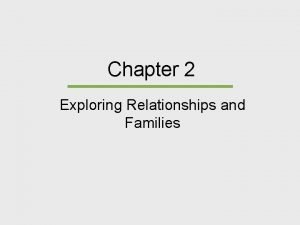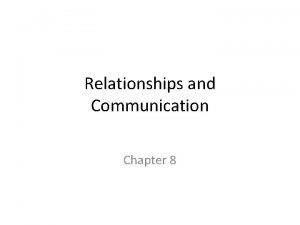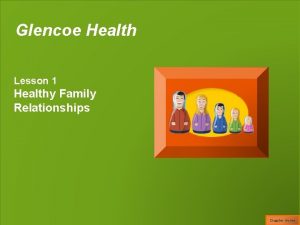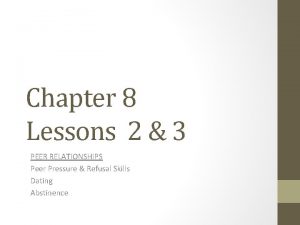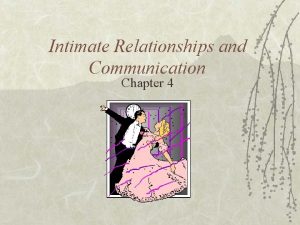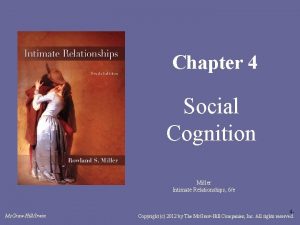Chapter 7 Friendship Miller Intimate Relationships 6e Mc




























- Slides: 28

Chapter 7 Friendship Miller Intimate Relationships, 6/e Mc. Graw-Hill/Irwin Copyright (c) 2012 by The Mc. Graw-Hill Companies, Inc. All rights reserved.

Power of Friendship • Longevity Project Findings: 85 year longitudinal study. The secret to a long life! • Homeless Project: Richard Simmons work on reducing homelessness. Homeless individuals more likely to accept help and take care of themselves if they feel at least 1 person cares about them. 7 -2

The Nature of Friendships are based on the same building blocks of intimacy as romances are, but the mix of components is usually different. This chapter details what it means to like an intimate partner. 7 -3

The Nature of Friendship Attributes of Friendships are characterized by three themes: – Caring and affection – friends know each other well and care for each other – Support and dependability – friends are reliable sources of comfort and help – Enjoyment and fun – friends take pleasure in each other’s company 7 -4

The Nature of Friendship Attributes of Friendship Thus, friendship is: Selective “a voluntary, personal relationship, typically providing intimacy and assistance, in which the two parties like each another and seek each other’s company. ” (Fehr, 1996) 7 -5

The Nature of Friendship Different from Romantic Relationships Compared to romances, friendships are: – Less passionate – Less exclusive – Less confining, entailing fewer obligations to one’s partner 7 -6

The Nature of Friendship Attributes of Friendship Still, rich friendships are intimate relationships, involving: – – – respect trust capitalization social support responsiveness 7 -7

The Nature of Friendship Attributes of Friendship Responsiveness involves attentive and supportive recognition of our needs and interests. Capitalization occurs when others enthusiastically enhance our happiness by being excited when good things happen to us. 7 -8

The Nature of Friendship Attributes of Friendship Social support may be of three types: – Emotional support in the form of affection and acceptance – Advice support in the form of information and guidance – Material support in the form of money and goods 7 -9

The Nature of Friendship Why is Friendship Essential? Social Support is good for our health! -Sensitive support from others reduces our stress and draws us closer to them… - People with secure attachment styles give more effective support than insecure people do. (make better friends) 7 -10

The Nature of Friendship Perception of Support more important However, it’s not what people do for us, but what we think they do for us that matters in the long run… …and we perceive our partners to be more supportive when we are happy with them and securely attached to them. 7 -11

The Nature of Friendship The Rules of Friendship? There are standards of conduct in friendships that can make or break those relationships. - Boundaries of Friendships - Taboos 7 -12

The Nature of Friendship The Rules of Friendship Here are examples of the rules: – – – – Volunteer help in time of need Trust and confide in each other Stand up for the other person in his or her absence Don’t criticize each other in public Show emotional support Strive to make him or her happy while in each other’s company Don’t be jealous or critical of each other’s relationships Share news of success with the other Ask for personal advice Don’t nag Engage in joking or teasing with the friend Seek to repay debts and favors and compliments Disclose personal feelings or problems to the friend 7 -13

How Do We Learn to be Friends? Childhood: socialization Age 2: Parallel Play Toddlers play along side each other Age 3: Cooperative Play Toddlers play together cooperatively and take evident pleasure in each other’s company. They can be said to have rudimentary friendships. 7 -14

Friendship Across the Life Cycle Childhood Children’s friendships gradually become richer and more complex as they age. The sophisticated ways in which adults conduct their friendships are years in the making. Q: What are they learning that will help them in complex intimate relationships later? 7 -15

Friendship Across the Life Cycle Childhood: Psycho-Social Stages of Dev (Erikson) 0 -2 Trust/Mistrust 2 -4 Autonomy/Shame 4 -5 Initiative/Guilt 5 -12 Industry/Inferiority 13 -19 Identity/Confusion: belonging to groups 20 -39 Intimacy/Isolation: first sig relationship 7 -16

Friendship Across the Life Cycle Adolescence: Transition of Attachment • Teens spend less and less time with their families, and more time with their peers. • Their social networks change over time, as same-sex cliques are gradually replaced with romantic partnerships. • Social pressure reaches a peak around the age of fifteen. 7 -17

Friendship Across the Life Cycle Adolescence • Attachment theorists identify four components of attachment: – – Proximity Seeking Separation Protest Safe Haven Secure Base • As they grow older, adolescents gradually shift their primary attachments from their parents to their peers in a component-by-component fashion. 7 -18

Friendship Across the Life Cycle Young Adulthood • College students tend to seek proximity and safe haven with friends, but are still likely to rely on parents as a secure base. • Erikson’s stage of Intimacy vs. Isolation After college, people tend to interact with fewer friends but have deeper, more interdependent relationships with the friends they do have. 7 -19

Friendship Across the Life Cycle Midlife A pattern of dyadic withdrawal occurs when people settle into romantic relationships: As they see more and more of a lover, they see less and less of their friends… …particularly their friends of the other sex. 7 -20

Friendship Across the Life Cycle Old Age Elderly people have smaller social networks than younger people do: They have just as many close friends, but they spend less time with casual friends. The best explanation comes from socioemotional selectivity theory, which holds that – because they’re focused on the present instead of the future – elderly people seek quality, not quantity in their close relationships. 7 -21

Friendship Across the Life Cycle Old Age; Power of an Emotional Bond Overall, elderly people who have close friends live longer, healthier lives than do those who are less connected to others. Friendships are invaluable for as long as we live. 7 -22

Differences in Friendship Gender Differences in Same-Sex Friendships Women’s friendships are characterized by emotional sharing and self-disclosure. Men’s friendships revolve around shared activities, companionship, and fun. 7 -23

Differences in Friendship Gender Differences in Same-Sex Friendships Women’s same-sex friendships tend to be closer and more intimate than men’s are. Why? (A) traditional gender roles, (B) social norms that encourage emotional constraint, and (C) homophobia discourage intimacy in men’s friendships. 7 -24

Differences in Friendship Individual Differences in Friendship There are several differences from person to person that influence the friendships we form. • Self-monitoring -- Low self-monitors have fewer friends, but their friendships are more intimate than those enjoyed by high self-monitors. 7 -25

Friendship Difficulties Shyness : Link to Adult Anxiety Dx • Shy people worry about social disapproval. • Shy people manage small talk poorly. • Shy people behave in a timid manner, often making the negative impressions they hoped to avoid. • Many shy people stay relaxed and interact comfortably with others when given an excuse for the interaction to go poorly, so they need greater self-confidence, not better social skills. 7 -26

Friendship Difficulties Loneliness • Distress occurs when we want more, or more intimate, connections with others. • • Social isolation Emotional isolation Genetic influences Certain personalities Insecure attachment Low self-esteem Low expressivity • Associated with negative attitudes; is unappealing to others. • However, loneliness can be overcome. • Hopeful attributions and reasonable expectations are helpful. 7 -27

For Your Consideration Group Work Clinical Cases: (handout) Examine each case presentation in light of lecture on friendship, social development and emotional intimacy. Class Discussion of Cases 7 -28
 Family life today
Family life today Love and communication in intimate relationships
Love and communication in intimate relationships Friendly relationship chapter 7
Friendly relationship chapter 7 Intimacy after incarceration
Intimacy after incarceration Intimate family chapter 6
Intimate family chapter 6 Intimate family chapter 6
Intimate family chapter 6 Intimate family chapter 2
Intimate family chapter 2 Intimate family chapter 2
Intimate family chapter 2 Miller
Miller Daniel miller arthur miller
Daniel miller arthur miller Medical plaza miller 131 miller street
Medical plaza miller 131 miller street Intimate distance
Intimate distance Consultative register examples
Consultative register examples Dewgarden foaming intimate wash benefits
Dewgarden foaming intimate wash benefits Intimate zone in communication
Intimate zone in communication Intimate zone in communication
Intimate zone in communication Scary antonym
Scary antonym Me line 02 intimate
Me line 02 intimate Abcde of intimate relationship
Abcde of intimate relationship The spyware used in intimate partner violence
The spyware used in intimate partner violence Friendly relationship chapter 9
Friendly relationship chapter 9 Friendly relationship chapter 7
Friendly relationship chapter 7 Friendship relationship chapter 7
Friendship relationship chapter 7 Setting of daisy miller
Setting of daisy miller Glencoe health chapter 7
Glencoe health chapter 7 Chapter 8 peer relationships answer key
Chapter 8 peer relationships answer key Chapter 7 lesson 1 healthy family relationships
Chapter 7 lesson 1 healthy family relationships Principles of ecology section 2 flow of energy
Principles of ecology section 2 flow of energy Principles of ecology chapter 2 section 1 answer key
Principles of ecology chapter 2 section 1 answer key







